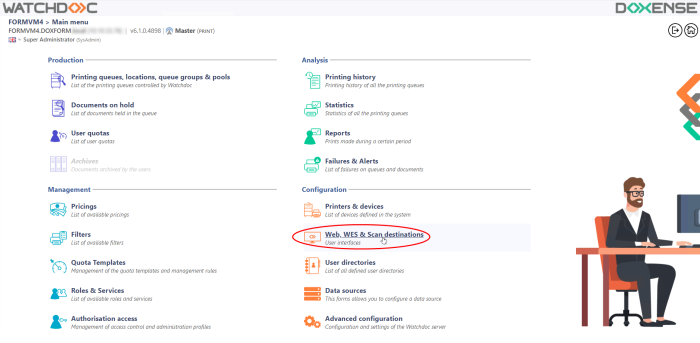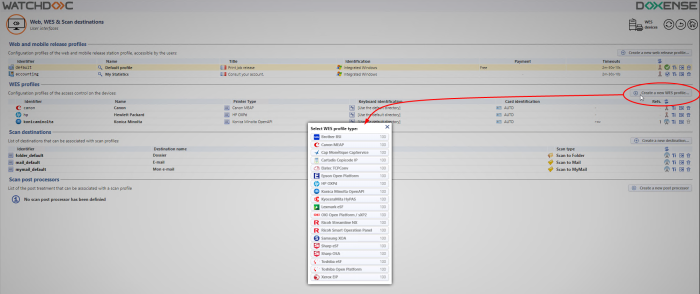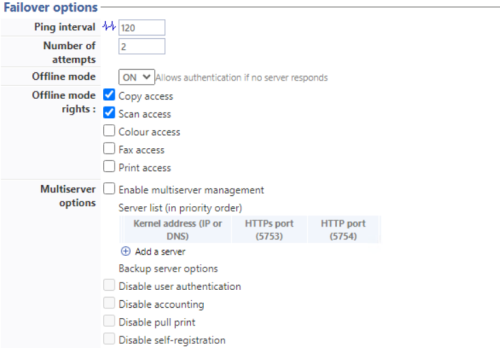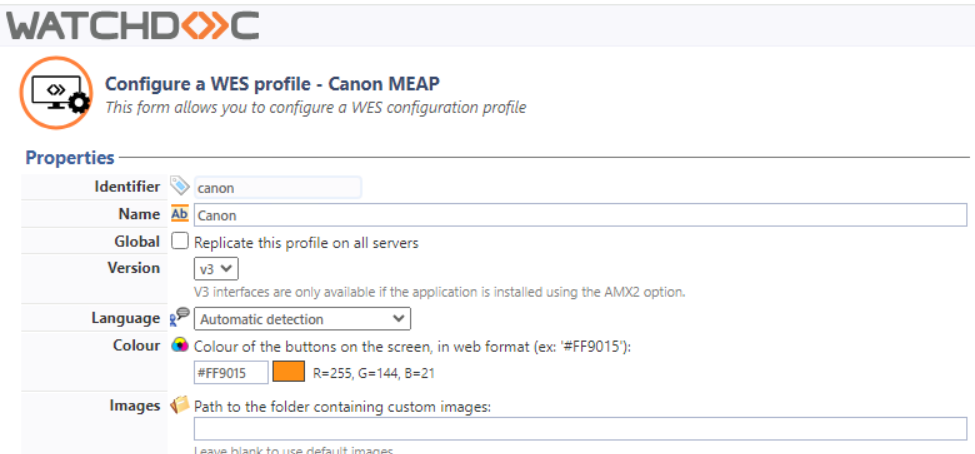Canon WES - Create and configure the WES profile
Create the WES profile
On a clean Watchdoc installation, a first WES profile is automatically created with default parameters at the end of the wizard procedure, but you can, at any time, edit existing profiles to modify them or create a new profile.
-
From the Main menu in the administration interface;
-
in the Configuration section, click on Web, WES & Scan destinations:

-
in the Web, WES & Scan Destinations - Client Interface Management interface, click on Create a new WES profile;
-
in the list, select the profile you want to create:

è you will access the Create a WES profile form, which contains a number of sections in which you can configure your WES.
A navigation bar helps you quickly access the desired section:
Configure the WES profile
Configure the Properties section
Use this section to state the main WES properties:
-
Identifier: Enter the single identifier for the WES profile. It can comprise letters, numbers and the '_' character with a maximum of 64 characters. This identifier is only displayed in the administration interfaces.
-
Name: enter the WES profile name. This explicit name is only displayed in the administration interfaces.
-
Global : in the case of a master/slave configuration, tick this box to replicate this profile on the slave servers.
-
Language: Select the WES display language configured from the list. If you select Automatic detection, the WES adopts the language it finds by default in the device configuration.
-
Version: select the version of WES. For v3, you can customise the interface by choosing the colour of the buttons and images to match your graphic identity:
-
Colour: enter the Hexadecimal color value corresponding to the WES button's colour. By default, the buttons are Watchdoc orange customized (#FF901). Once the value is entered, the colour is displayed in the field.
-
Images: if you want to customize the WES images, enter the folder path in which are recorded images you want to display instead of the default images (stored in C:\Program Files\Doxense\Watchdoc\Images\Embedded\Doxense\[Manufacturer_Name] by default).
-
Configure the Keyboard authentication section
You can activate Keyboard and/or Card authentications. For each option, you have to select the directory that Watchdoc will use for authentication requests.
Enable: tick the box (at the section level) to enable user authentication from a physical keyboard or the touch screen one, then set out how this authentication works:
-
Directory: from the list, select the directory to query during keyboard authentication. If no directory is set, Watchdoc will query the default directory.
-
Authentication mode: Specify how users are to authenticate themselves (entering a PIN code, a PUK code or an account and password).
-
PUK code authentication: codes are generated automatically by Watchdoc (Generation parameters are in the directory form);
-
Login and PIN Code: consisting of 4 or 5 digits, the user PIN code (1234, for example) is registered as an LDAP attribute or in a CSV file. It is associated to the user login (available with the Watchdoc 5.1 version).
-
Login and password: users will use their LDAP credentials. We do not recommend using this mode.

-
Configure the card authentication mode
Tick the box (at the section level) to enable user authentication from a card, then set out how this authentication works:
-
Directory: From the list, select the directory to query during badge authentication. If no directory is set, Watchdoc will query the default directory.
-
Self Registration: : If you enable enrollment1 from the WES, state how the user assigns their card to their account, using their PUK code or their account and password.
Disabled: the self-registration is not allowed: if the user is unknown, an error message is displayed;
-
with PUK code: the embedded solution will ask the user for its PUK code. If the PUK code is correct, Watchdoc stores the card number with the user's login in its database;
-
Login and PIN code: the embedded solution will ask the user for his login and PIN Code. If the data are correct, Watchdoc stores the PIN Code in a database (.json or SQL database).
-
Login and password: users will use their LDAP credentials. We do not recommend using this mode.
-
Notify the user on self-registration: check this box to send a notification to the user when his badge has been enrolled.
-
-
Format: State, where necessary, how the character string for the badge number string is to be transformed. E.g. raw;cut(0,8);swap.

Configure the Anonymous connection section
Tick this section to activate the Anonymous connection in order to allow an unauthenticated user to access to the device by clicking a button.
It is possible to restrict the features that the anonymous user can access by applying a privilege policy to the queue, group, or server, and using the Anonymous User filter.
-
Button Label: Enter in this field the label displayed on the access button to the device features. By default, the text is Anonymous;
-
Redirection: From the list, choose the application to which the anonymous user must access after clicking the Anonymous:
-
Home: The user accesses to the device homepage;
-
Copy Application: The user accesses to the copy application;
-
Scan Application: The user accesses to the scan feature;
-
Fax application: The user accesses to the scan feature;

-
Configure the Quota section
Not compatible with Anonymous connection
-
Enable: tick the box to enable the WES to manage print quotas.

Configure the Pull print section
In this section, you can change options about the Watchdoc release application: sort order of the document, tariff information and optional pages.
You can bypass this application by enabling the automatic release mode. When the user is authenticated on the device, all its documents are released.
-
Sort Order: Set the documents order on the device screen:
-
Reverse chronological: More recent documents will top the list;
-
Chronological: Older documents will top the list.
-
Release all documents at login: When the user logs on by swiping his card or typing his PIN code, Watchdoc releases all user documents on the device where he logs on.
-
-
Optional pages - Enable Page Zoom: Select this checkbox to enable the user to zoom in on jobs waiting to be printed (PCL 6 driver required).
-
Display options: monetary information presented to the user Select which information will be displayed to the users : none, cost or price ;
-
Force the monetary display to 2 decimal digits: Tick the box to limit the number of decimal digits displayed to the user in the tariff information.
-
monetary information presented to the user Select which information will be displayed to the users (none, cost, price
-
-
Monetary symbol: Tick the box if you want to customize the monetary symbol and enter a currency symbol other than the default € one in the Symbol field:

Configure the Device section
This section is used to define the connection mode between the server and the print devices.
-
Network: the two values can be used to set :
-
Connection timeout (sec.): the maximum waiting time for the connection between the copier and Watchdoc during a request (server off or service stopped);
-
Request timeout (sec.): the waiting time for processing the request: retrieving information about a user, sending and processing accounting requests.
-
-
Server Address: The device needs to contact the Watchdoc server when the user tries to connect or wants to release his documents. You can specify the Watchdoc server address in three different ways: IP Address, DNS Address or Custom Address;
-
Mixed: the application uses SSL for sensitive data (PUK code, login/mdp, etc.) and not SSL for non-sensitive data;
-
No SSL: Select this item if the WES does not ever use SSL to communicate with the server.
-
-
Device security: indicate the device administrator login and password which Watchdoc needs to communicate with it during certain operations (automatic installation, requests, etc.).
-
Connection Mode: Enables you to select the communication mode between the WES and lWatchdoc to specify whether access is secure or not:
-
SSL: the WES uses SSL exclusively to communicate with the server;*
-
Mixed: the WES uses SSL for sensitive data (PUK code, login/mdp, etc.) and not SSL for non-sensitive data;
-
SSL disabled: the WES never uses SSL to communicate with the server. It is recommended not to use login/password connection or enrolment with this setting.
-
-
Secure endpoint: if you have selected an SSL or Mixed connection mode, since v. 6.1.0.5262 you can specify whether you wish to use:
-
the custom access point (previously configured in the DSP section (see Configuring the Web Server):
-
the Watchdoc server's default port 5753 ;
-
-
TLS/SSL - Use a secured connection: This box is checked by default and forces Watchdoc to communicate with the device using SSL, even if the device is configured to communicate with Watchdoc using non-SSL. This setting is necessary if the device only supports incoming communications using SSL.
-
Licence file management: these fields are used to manage Canon licences if they are to be applied en masse to a large number of devices (more than 11 simultaneously). In this case, you should have downloaded and saved the 2 licence files beforehand. You can then tick the box and indicate in the following 2 fields the folder in which the licence files are saved:
-
Authentication application's licence file name: indicate in this field the name of the licence file used for authentication;
-
Pull print application's licence file name: enter the name of the print-on-demand licence file in this field.

-
Configure the Scan to home folder section
Check the box to enable this scanning feature supported by the device. Once authenticated in the WES, the user will see a "Scan" button that sends them to the Canon scanning function.
To access this function, Watchdoc needs the following parameters:
-
Credentials: provide the parameters enabling Watchdoc to access the function (if these are not the default parameters).
-
Domain: enter the name of the directory in which the access account is registered;
-
Account name: the account must have write access to the specified subfolder;
-
Password: enter the password for the account authorised to write to the specified subfolder.
-
-
Options - Subfolder: use this field to specify the subfolder (specific to scans) to be created in each of the user's personal folders.

Configure the Failover options section
In this section, you configure the behaviour of the print devices in the event that the Watchdoc server does not respond.
-
Ping interval: specify, in seconds, the frequency with which the device polls the server to check its configuration and inform it that it is operating correctly;
-
Number of attempts: specify the number of connections the device should attempt to the main server before switching to the standby server.
-
Offline mode: activate or deactivate offline mode
 Mode enabling the print device to operate in a degraded manner in the event of the print servers (main and backup) failing. In offline mode, printing is impossible, but the device's other functions can be offered: photocopying, faxing and scanning.
If offline mode is disabled, in the event of a server failure, all device functions are blocked until the server is repaired.
This mode is configured in the WES profile applied to the device. and complete the list by indicating the authorised functions if the server is off:
Mode enabling the print device to operate in a degraded manner in the event of the print servers (main and backup) failing. In offline mode, printing is impossible, but the device's other functions can be offered: photocopying, faxing and scanning.
If offline mode is disabled, in the event of a server failure, all device functions are blocked until the server is repaired.
This mode is configured in the WES profile applied to the device. and complete the list by indicating the authorised functions if the server is off: -
Copy access: Tick this box to enable the user to copy;
-
Scan access: Tick this box to enable the user to scan;
-
Color access: Tick this box to enable the user to print in color;
-
Fax access: Tick this box to enable the user to send documents by fax;
-
Print access: Tick this box to enable the user to print documents.
-
Device administration right: tick the box to authorize the user to access device administration.
-
-
Multiserver options: tick this box to relay requests to a backup server in the event of failure of the server with which the WES is associated, then enter the information required to access it in the table: backup server address; https port; http port.
Then check the functions provided by the backup server:-
Disable user authentication: tick this box if the rescue server does not authenticate users. For each request, it returns the details of an anonymous user with the rights defined for an anonymous user on the main server. The work carried out is then recorded under the "anonymous" account;
-
Disable accounting: If this is checked the accounting elements will be held on the device until it reconnects to the primary server. This is useful if you wish the accounting to be all sent to the same sever (if the databases are not common for example).
-
Disable pull print: With this option, the print on demand application will be disabled. This is useful because if the backup server has no access to the jobs of the user.
-
Disable self-registration: With this option, the self-registration will not be available on the backup server. This is useful if the cards database are not the same for both servers.

-
Configure the Misc. section
In this section, configure how and where the log files should be stored in the event of a of a malfunction between the WES and the server.
-
Log options - Destination: Specify where the application should collect the information:
-
file: Tick this box so that the information is saved in a file accessible by Watchdoc;
-
device: Tick this box so that the information is saved on the device;
-
all : Check this box to have the information saved in a file accessible by Watchdoc and on the device.
-
-
Log options - Level: indicate the level of detail of the information recorded:
-
debug: Option to keep track of WES malfunctions;
-
verbose: All detailed traces left by the WES;
-
info: Traces left by the WES;
-
warning: Traces left by the WES when there is a default;
-
error: Traces left when an error is detected at the WES.
-
fatal: Traces of faults detected on the WES
-
none: No trace

-
Configure the History section
This section displays information on the configured WES and on modifications made to it :
Validate the profile
1. Click on the button  to validate the WES profile configuration.
to validate the WES profile configuration.
→ Once validated, the WES profile can be applied to a print queue.
